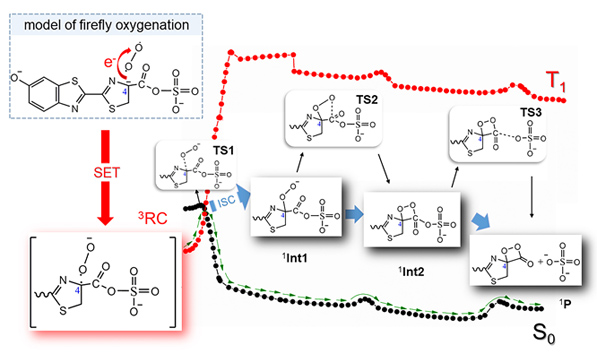[1] Chen, F.; Liu, S.; Duan, X. Acta Chim. Sinica 2013, 71, 1035(in Chinese). (陈浮, 刘树深, 段欣甜, 化学学报, 2013, 71, 1035.)
[2] Wilson, T.; Hastings, J. W. Annu. Rev. Cell. Dev. Bi. 1998, 14, 197.
[3] Haddock, S. H. D.; Moline, M. A.; Case, J. F. Annu. Rev. Mar. Sci. 2010, 2, 443.
[4] Lee, J. Bioluminescence, the Nature of the Light, University of Georgia, 2020, pp. 102~114.
[5] Ando, Y.; Niwa, K.; Yamada, N.; Enomot, T.; Irie, T.; Kubota, H.; Ohmiya, Y.; Akiyama, H. Nat. Photonics 2008, 2, 44.
[6] Wood, K. V. Photochem. Photobiol. 1995, 62, 662.
[7] Ugarova, N. N.; Brovko, L. Y. Luminescence 2002, 17, 321.
[8] Schmidt, S. P.; Schuster, G. B. J. Am. Chem. Soc. 1978, 100, 1966.
[9] Day, J. C.; Tisi, L. C.; Bailey, M. J. Luminescence 2004, 19, 8.
[10] Navizet, I.; Liu, Y.-J.; Ferre, N.; Xiao, H.-Y.; Fang, W.-H.; Lindh, R. J. Am. Chem. Soc. 2010, 132, 706.
[11] Orlova, G.; Goddard, J. D.; Brovko, L. Y. J. Am. Chem. Soc. 2003, 125, 6962.
[12] Wilsey, S.; Bernardi, F.; Olivucci, M.; Robb, M. A.; Murphy, S.; Adam, W. J. Phys. Chem. A 1999, 103, 1669.
[13] Min, C.; Li, Z.; Cui, X.; Yang, X.; Huang, S.; Wang, S.; Ren, A. Chin. J. Org. Chem. 2015, 35, 432(in Chinese). (闵春刚, 李作盛, 崔小英, 杨喜昆, 黄绍军, 王绍华, 任爱民, 有机化学, 2015, 35, 432.)
[14] Yue, L.; Liu, Y.-J.; Fang, W.-H. J. Am. Chem. Soc. 2012, 134, 11632.
[15] Yue, L.; Lan, Z.; Liu, Y.-J. J. Phys. Chem. Lett. 2015, 6, 540.
[16] Cheng, Y.-Y.; Liu, Y.-J. ChemPhysChem 2019, 20, 1720.
[17] Branching, B. R.; Rosenberg, J. C.; Fontaine, D. M.; Southworth, T. L.; Behney, C. E.; Uzasci, L. J. Am. Chem. Soc. 2011, 133, 11088.
[18] Marahiel, M. A.; Stachelhaus, T.; Mootz, H. D. Chem. Rev. 1997, 97, 2651.
[19] Westheimer, F. H. Science 1987, 235, 1173.
[20] Barrozo, A.; Blaha-Nelson, D.; Williams, N. H.; Kamerlin, S. C. L. Pure Appl. Chem. 2017, 89, 715.
[21] Duarte, F.; Åqvist, J.; Williams, N. H.; Kamerlin, S. C. L. J. Am. Chem. Soc. 2015, 137, 1081.
[22] Duarte, F.; Barrozo, A.; Åqvist, J.; Williams, N. H.; Kamerlin, S. C. L. J. Am. Chem. Soc. 2016, 138, 10664.
[23] Nelson, D. L.; Cox, M. M. Lehninger Principles of Biochemistry, 7th ed., W. H. Freeman and Company, New York, 2013, pp. 1370~1380.
[24] Koo, J.-Y.; Schuster, G. B. J. Am. Chem. Soc. 1977, 99, 6107.
[25] Branchini, B. R.; Behney, C. E.; Southworth, T. L.; Fontaine, D. M.; Gulick, A. M.; Vinyard, D. J.; Brudvig, G. W. J. Am. Chem. Soc. 2015, 137, 7592.
[26] Berraud-Pache, R.; Lindh, R.; Navizet, I. J. Phys. Chem. B 2018, 122, 5173.
[27] Hirano, T.; Hasumi, Y.; Ohtsuka, K.; Maki, S.; Niwa, H.; Yamaji, M.; Hashizume, D. J. Am. Chem. Soc. 2009, 131, 2385.
[28] Shimomura, O. In Bioluminescence:Chemical Principles and Methods, World Scientific Publishing Co. Pte. Ltd., Singapore, 2006.
[29] Ding, B. W.; Liu, Y. J. J. Am. Chem. Soc. 2017, 139, 1106.
[30] Luo, Y.; Liu, Y.-J. J. Phys. Chem. A 2019, 123, 4354.
[31] Zhao, Y.; Truhlar, D. G. Theor. Chem. Acc. 2007, 120, 215.
[32] Perdew, J. P.; Ruzsinszky, A.; Tao, J. M.; Staroverov, V. N.; Scuseria, G. E.; Csonka, G. I. J. Chem. Phys. 2005, 123, A1133.
[33] Dreuw, A.; Head-Gordon, M. Chem. Rev. 2005, 105, 4009.
[34] Boggio-Pasqua, M.; Heully, J.-L. Theor. Chem. Acc. 2015, 135, 9.
[35] Ess, D. H.; Cook, T. C. J. Phys. Chem. A 2012, 116, 4922.
[36] Gilson, M. K.; Honig, B. H. Biopolymers 1986, 25, 2097.
[37] Pitera, J. W.; Falta, M.; van Gunsteren, W. F. Biophys. J. 2001, 80, 2546.
[38] Cossi, M.; Rega, N.; Scalmani, G.; Barone, V. J. Comput. Chem. 2003, 24, 669.
[39] Nakatani, N.; Hasegawa, J.-y.; Nakatsuji, H. J. Am. Chem. Soc. 2007, 129, 8756.
[40] Frisch, M. J.; Trucks, G. W.; Schlegel, H. B.; Scuseria, G. E.; Robb, M. A.; Cheeseman, J. R.; Scalmani, G.; Barone, V.; Mennucci, B.; Petersson, G. A.; Nakatsuji, H.; Caricato, M.; Li, X.; Hratchian, H. P.; Izmaylov, A. F.; Bloino, J.; Zheng, G.; Sonnenberg, J. L.; Hada, M.; Ehara, M.; Toyota, K.; Fukuda, R.; Hasegawa, J.; Ishida, M.; Nakajima, T.; Honda, Y.; Kitao, O.; Nakai, H.; Vreven, T.; Montgomery, J. J. A.; Peralta, J. E.; Ogliaro, F.; Bearpark, M.; Heyd, J. J.; Brothers, E.; Kudin, K. N.; Staroverov, V. N.; Keith, T.; Kobayashi, R.; Normand, J.; Raghavachari, K.; Rendell, A.; Burant, J. C.; Iyengar, S. S.; Tomasi, J.; Cossi, M.; Rega, N.; Millam, J. M.; Klene, M.; Knox, J. E.; Cross, J. B.; Bakken, V.; Adamo, C.; Jaramillo, J.; Gomperts, R.; Stratmann, R. E.; Yazyev, O.; Austin, A. J.; Cammi, R.; Pomelli, C.; Ochterski, J. W.; Martin, R. L.; Morokuma, K.; Zakrzewski, V. G.; Voth, G. A.; Salvador, P.; Dannenberg, J. J.; Dapprich, S.; Daniels, A. D.; Farkas, O.; Foresman, J. B.; Ortiz, J. V.; Cioslowski, J.; Fox, D. J. Gaussian 09, Revision D. Gaussian Inc., Wallingford, 2009. |
